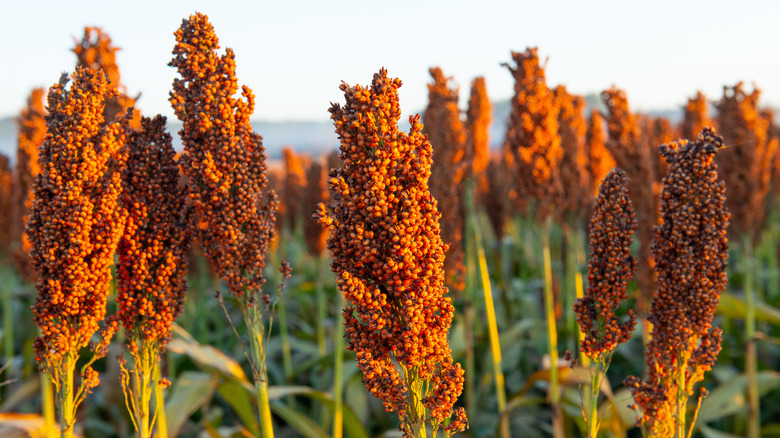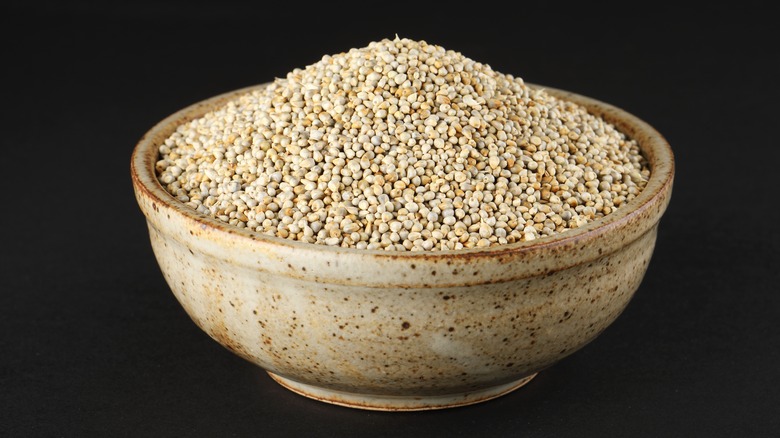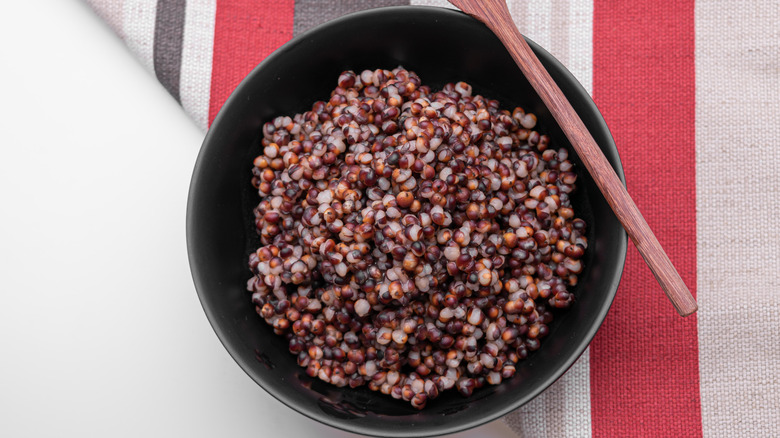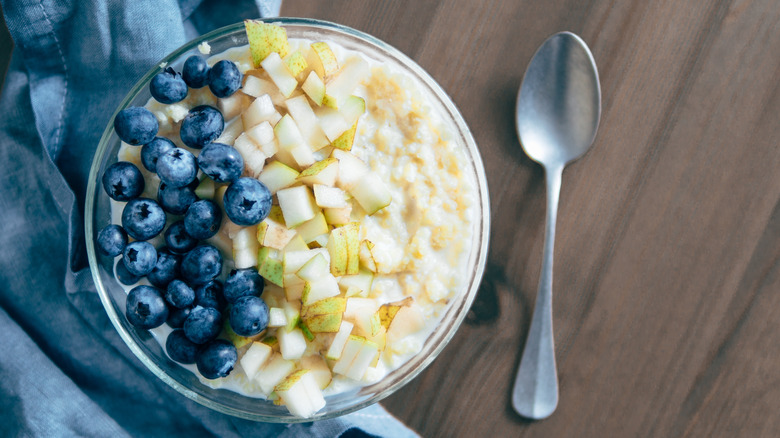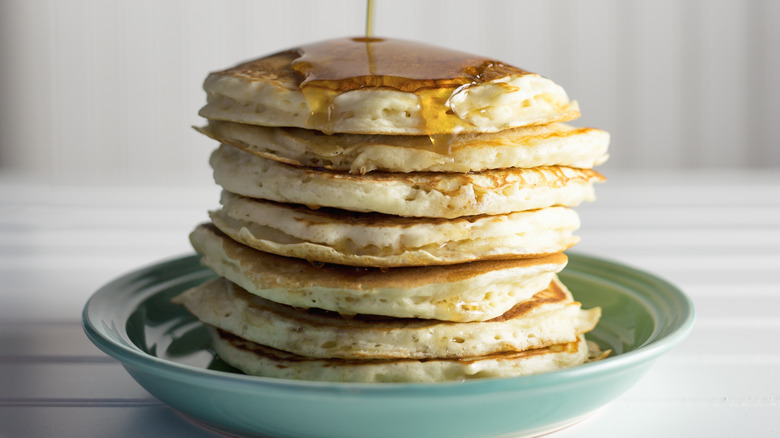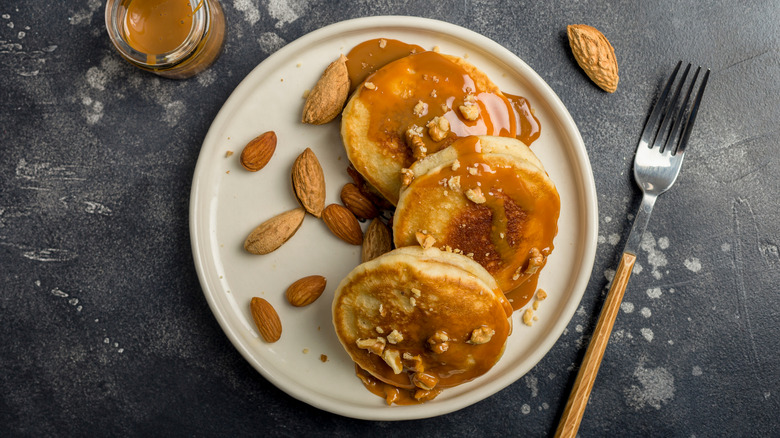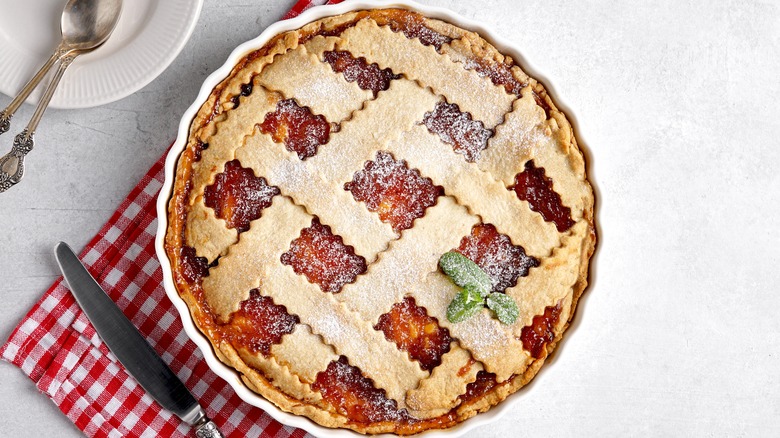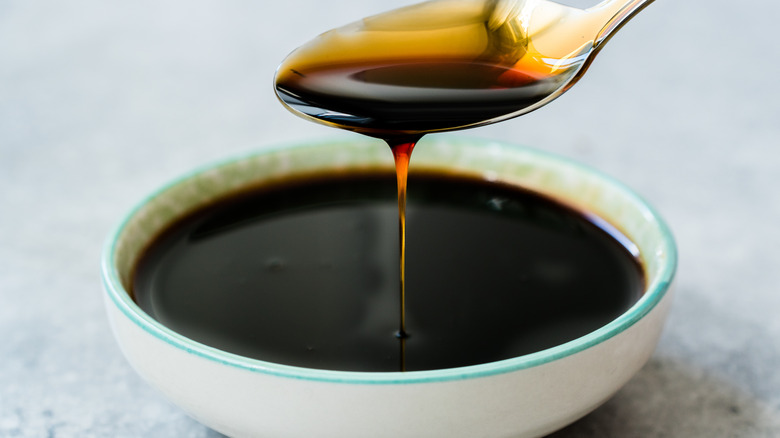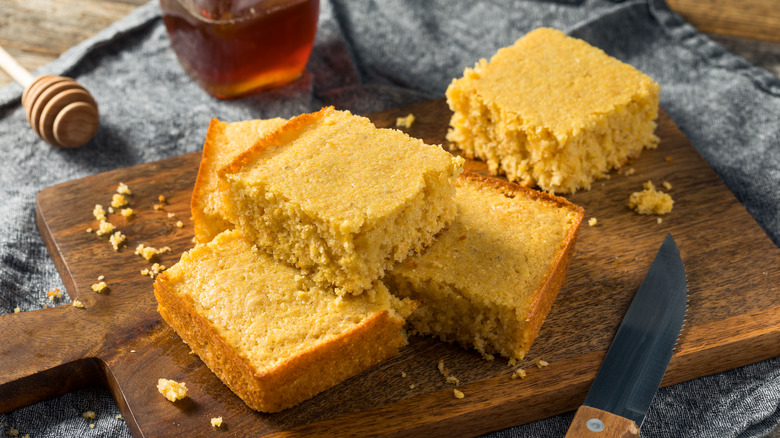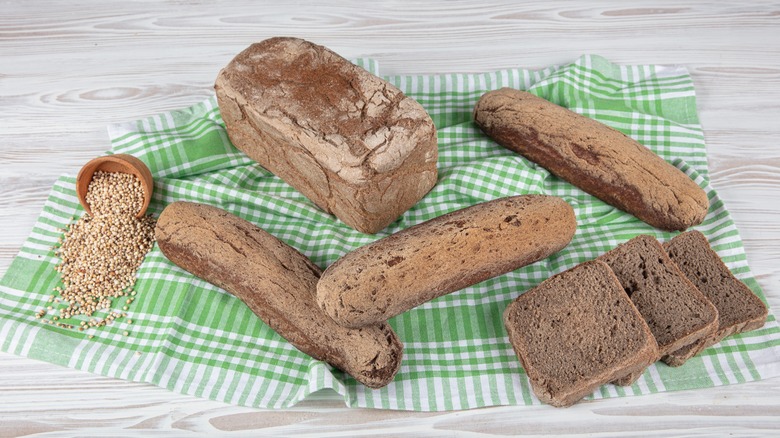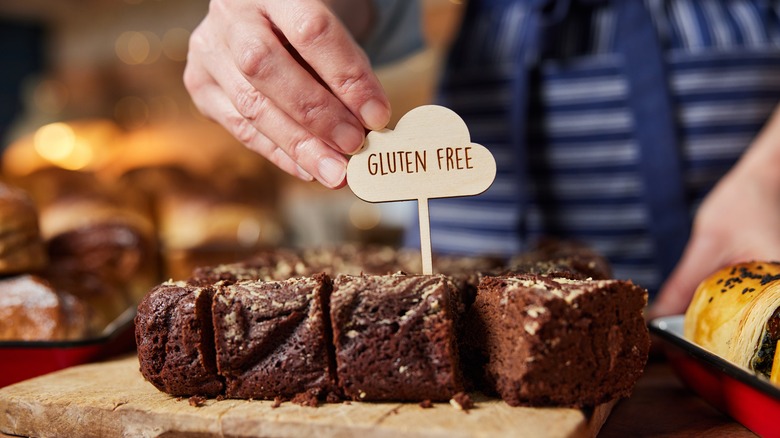Chefs Explain What Sorghum Is And What You Can Do With It
Sorghum isn't the most common ingredient out there, but it comes in several forms and is surprisingly versatile, making it perfect for anyone who loves to experiment in the kitchen. Whether you choose sorghum serum, sorghum flour, or sorghum grains, there are plenty of great ways to cook with it. First, though, you might want to learn what sorghum is and how its various types differ.
There's plenty you can do with this ingredient if you know how, so we consulted some experts — no less than six, in fact — who love cooking with sorghum so we could learn insider tips on the best ways to use it. From popping sorghum grains to give dishes texture to using sorghum syrup to give baked goods a complex sweetness, there's much more to this grain than you might have imagined.
We're about to answer two important questions: What is sorghum, and what can you do with it? If you've never cooked with this ingredient, prepare to have your mind blown. Even if you have experience with it, though, we bet you're going to learn something new.
The lowdown on sorghum
If you're not totally certain what sorghum is, then this is the place to start. In short, it's a grain. "Sorghum is a member of the grass family and is grown alongside other cereal grains," said Jonathan Metcalf, pastry chef at The Barn at Blackberry Farm. He told Mashed, "It's one of the world's most important crops and is a great naturally gluten-free ingredient."
It's the fifth most-produced grain after wheat, rice, barley, and corn, but it's a distant fifth, which is why many folks have never heard of it (let alone cooked with it). Culinarily, it comes in three forms: sorghum grains, sorghum flour, and sorghum syrup. Sorghum grains are the whole grains from the plant. You can cook them in a number of ways, which we'll get into later on.
Next is sorghum syrup, which is particularly popular in the American South. "Where many people think of molasses or maple syrup, sorghum is THAT ingredient for Southerners," said Scott Franqueza, the executive chef at High Hampton. The final type is sorghum flour, which is the milled grain that's used as an alternative to wheat flour. Now that you know more about sorghum and the varieties available, it's time to learn what you can do with them.
You can pop sorghum grains
Move over, popcorn — popped sorghum has entered the building. Yep, that's right, you can pop sorghum (and basically any other grain) the way you pop corn. "In the pastry world, we sometimes pop the kernels, just like normal popcorn, although the popped sorghum is smaller and has a bit [of a] crunchier texture," said Jonathan Metcalf. The popped grain can be used to top desserts and baked goods, giving them a satisfying crunch and a slightly nutty flavor.
But it's not just good for sweet dishes. Chef Greg Garrison uses it on his menu at Repeal 33 in Savannah, Georgia. "Since we're located near the coast and like to take advantage of the fresh seafood from our local waters, puffed sorghum is an impactful addition to crudo and ceviche, as it adds crunch and a subtle Southern flavor," he told Mashed. Chef Matt Bolus of The 404 Kitchen also likes to pop sorghum for some of his recipes. He told us it adds "a different textural element to a dish." If you're looking for a way to elevate dishes into fine-dining territory, puffing sorghum is definitely something to try.
Sorghum grains are a perfect alternative to rice or quinoa
If you're looking for an intro to the world of sorghum grains, the easiest thing you can do with them is just treat them like any other grain you'd have with a meal. "Sorghum is a great alternative to rice or quinoa," said Jonathan Metcalf. "The grain is larger than quinoa and just as nutritious." He said it's a great rice swap for burrito bowls with black bean, and it can even go in salads where you might otherwise use quinoa (or other grains).
Matt Bolus also recommended using it like you would other grains. He likes it "cooked and chilled and used in a salad, or used as a couscous substitute in tabbouleh." You can simply cook it up — using this Instant Pot sorghum recipe, for instance — and serve it on the side, like you might serve rice with a curry. You can also incorporate it into other dishes, like soups, stews, or even fried rice dishes.
But that's not the only way you can use it to replace other grains. "We use sorghum grains in a savory granola that is served with our cheese platter to add a subtle, natural sweetness," said Greg Garrison. Quinoa and other cereal grains are often used in a similar manner.
You can make porridge out of sorghum grains
People can make all kinds of mistakes with oatmeal, but even if you're making it right, eating the same thing over and over again can get boring. The next time you want to make a filling, nutritious breakfast, try branching out into sorghum. You can "use sorghum grains as an alternative to traditional oatmeal or porridge," said Jonathan Metcalf, adding, "It can be a great breakfast with dried or fresh fruits."
It doesn't just have to make sweet porridge, though. "It makes a great addition to a warm savory porridge," said Matt Bolus. Some people eat savory oatmeal dishes for breakfast, and you can do the same with savory sorghum porridge. This version could be served as part of dinner and used in recipes similar to ones for which you might use grits. Sorghum porridge has a pleasantly chewy texture that many people enjoy.
It is, however, more time-consuming to make sorghum porridge than oatmeal. You first need to cook the sorghum before simmering it with milk and other ingredients to make a porridge. If you're making sweet sorghum porridge, adding fragrant spices like cinnamon and nutmeg is a nice touch.
Sorghum syrup can be used as an alternative to maple syrup or honey
The stalks of the sorghum plant can be processed and made into a syrup, which is yet another way to use this versatile ingredient. "Sorghum syrup is used very much like honey or maple syrup in most cases," said Matt Bolus, adding, "Pancakes, toast, biscuits, anything that requires a drizzle of sweetness, sorghum can be used on." So, if you're looking for a cheaper alternative to maple syrup or a vegan alternative to honey, sorghum syrup might be the one.
But this isn't just a modern trend or a new food fad — it's traditional in Southern states. "My first introduction to sorghum was at an old country restaurant [where] I would go with my grandfather, and they always had sorghum syrup to put on their biscuits," Bolus remarked. And this syrup doesn't just add pure sweetness. "We use it to bring sweetness to a dish with a more interesting and nuanced flavor than we could achieve with sugar or honey," said Greg Garrison. It has slightly earthy and smoky notes with the slightest hint of bitterness, so you get a depth of flavor that some sweeteners lack.
Sorghum syrup is great in sauces
If you're looking for a sweetener for either a sweet or savory sauce, sorghum syrup can come to the rescue. As mentioned above, its flavor has plenty of complexity, so it adds something that not all sweeteners can. Plus, it's liquid, so it incorporates into sauces more easily than granulated sugar, which takes some time to dissolve.
According to Jonathan Metcalf, sorghum syrup "adds a rich, nutty sweetness to things like caramels, caramel sauce, and hot fudge." So, if you want to make a sweet sauce for a dessert, it's fun to experiment with this syrup. Your sauce might develop more nuanced notes than those in sauces made with cane sugar.
It can also be used in savory applications. "We often use sorghum syrup in sauces," said Joey Edwards, P.M. executive chef at Three Sisters Blackberry Mountain. You can basically use it in any sauce that needs some sweetness, whereas otherwise, you might use sugar or honey. This includes satay sauces, barbecue sauces, wine reductions, and much more. It's easy to mix this syrup straight into a sauce and give the coated ingredients a nice stickiness.
You can sweeten baked goods with sorghum syrup
Sugar is often the go-to sweetener for baked goods, but you can also use sorghum syrup. "Sorghum syrup is a staple in Southern and Appalachian cooking and baking, and it is one of my favorite ingredients," Jonathan Metcalf told Mashed. "My favorite recipe to use it in is my great-grandmother's Appalachian Stack Cake in the fall and winter." A stack cake (or apple stack cake) has multiple gingerbread-like layers filled with apple butter, and it sounds like an amazing way to use this syrup.
Matt Bolus noted that sorghum syrup can easily be used in a wide range of baked goods in place of honey, maple syrup, or sugar. "Use it when you want a sweet, but not too sweet, element in your recipe that won't give off a pronounced and known flavor like that of honey or maple syrup," he suggested. Cakes, cookies, cinnamon rolls, pies — they can all get the sorghum treatment.
But you don't just have to use it in sweet baked goods. It's great in breads and savory bakes, too. "I love incorporating sorghum into my rolls and baked goods," said April Franqueza, pastry chef at High Hampton. "It adds depth and sweetness that can't be obtained by any other ingredients. I even love to brush warmed sorghum on top of my dinner rolls, then sprinkle them with sea salt for some extra sweetness."
You can use sorghum syrup as an alternative to molasses
Sorghum syrup "can be used as an alternative to molasses and adds another depth of flavor to many recipes," as Jonathan Metcalf noted. It's an obvious choice if you're looking for a molasses alternative. This is because, as Metcalf pointed out, it's made in a way similar to molasses, just with sorghum instead of sugar cane. So, if you're looking for ingredients you can substitute for molasses and you happen to have sorghum syrup to hand, you're in luck.
Many recipes already call for molasses, including gingerbread, some rye breads, bagels, and sticky toffee pudding. It's simple to replace the molasses in a recipe with sorghum syrup, either because you don't have molasses or because you want to experiment with flavors. You can replace molasses with sorghum syrup using a 1-to-1 ratio. Their sweetness is about equal, but sorghum's is slightly more complex, so you can achieve some interesting flavors when using it as a substitute; however, it's worth noting that sorghum is thinner than molasses. Batters and doughs may, in turn, come out slightly thinner, but this is unlikely to make a significant difference in the finished dish.
Sorghum syrup makes an excellent glaze
There's no real secret behind making glazes (as opposed to sauces), but one thing they require is sweetness. This is part of what makes a sauce caramelize and thicken into glaze territory. While glazes can contain sugar, people often use liquid sweeteners because they don't need to dissolve, and they're often already thick and sticky. Sorghum syrup is no exception — it makes a great glaze ingredient.
Joey Edwards told us that the kitchen at Three Sisters Blackberry Mountain often uses sorghum syrup for glazes. "We do a glaze for pork belly where we grill fresh chamomile blossoms in a steel mesh basket over the wood fire, and then steep the smokey flowers in sorghum," he said, adding, "The grilled chamomile has an aroma similar to grilled pineapple, which is so delicious in the sweet sorghum syrup."
Scott Franqueza is also a fan of using this syrup as a glaze. "I like glazing pork or poultry with a mixture of jus and sorghum to add sweetness as well as umami," he said. So, the process is quite simple: Start with a liquid (like stock, wine, or soy sauce), add some sorghum syrup and an acidic ingredient for balance, mix in your choice of seasonings, and cook the mixture down to make yourself a delicious glaze.
You can add sorghum flour to cornbread recipes
Now we can dive into the world of sorghum flour. This flour is milled from the dried grains of the sorghum plant. It has a mild flavor with some sweetness and is finer in texture than some other non-wheat flours, which makes it a popular choice for gluten-free baking. If you love cornbread but want to mix things up, consider using sorghum flour as an alternative.
"I have used it on its own to make sorghum cornbread, replacing traditional cornmeal with ground sorghum flour," said Jonathan Metcalf, adding, "It's a great alternative if you're looking to change things up a bit in your cornbread baking adventures." Obviously, you won't get the same flavor as regular cornbread, but the flour is slightly sweet like cornmeal, and the finished bread has a similar texture.
You don't have to opt for an all-sorghum cornbread, however. Rather, you can use it in place of all-purpose flour in cornbread recipes that combine corn flour and wheat flour. Not only will this make your cornbread gluten-free, but it can help accentuate the slightly crumbly texture that many people like in the dish. You could even up the ante by using sorghum syrup as the sweetener.
Sorghum flour can be used to make gluten-free bread
We've already mentioned that sorghum flour is a popular choice for gluten-free baking, but that extends far beyond cornbread and into other types of bread. "We keep sorghum flour on hand for guests that request gluten-free bread," said Greg Garrison. So, it's something you can expect to find at his restaurant, Repeal 33.
But using sorghum flour to make bread isn't without its drawbacks. "Because there's no gluten, sorghum flour is more difficult to work with, so we have to use various techniques to make the structure," Garrison explained. People use various techniques to improve the texture of gluten-free bread, such as using eggs, mayonnaise, and even commercial products like Expandex. Additionally, you should always keep xanthan gum in your pantry if you want to make gluten-free bakes.
Sorghum flour is already a good contender for gluten-free bread, though, because it's high in protein, which helps create structure. That said, you generally won't just use one type of flour to make gluten-free bread. More likely, you'll use a blend that might contain other flours such as those made from millet, amaranth, buckwheat, rice, or gluten-free oatmeal. So, whether you can't consume gluten yourself or you're baking for someone who follows a gluten-free diet, sorghum could be the ticket to batter bread with no wheat (or other gluten flours) in sight.
You can use sorghum flour in cakes and other sweet bakes
If you're searching for gluten-free flour to use in cakes and other sweet baked goods, sorghum flour can come to your rescue. "I have used Sorghum Flour for a lot of gluten-free baking," said Jonathan Metcalf. "It is a great ingredient to add to homemade gluten-free mixes and is one of the main ingredients in many store-bought gluten-free flours. It can be used in this way for most gluten-free baking."
Matt Bolus mentioned some specific sweet treats he's made by incorporating sorghum flour: He's "played with it in some sweet bread recipes, pound cakes, shortbreads, biscuits, and scones." But gluten-free baking can be tricky. You can't just take your favorite gluten-containing recipes and switch out all-purpose flour with sorghum flour. This will likely leave you with a dry bake that falls apart, and it'll probably taste a bit weird, too.
Instead, you should search for a specific gluten-free recipe that calls for a generic blend or uses sorghum flour as one of its ingredients. As with baking gluten-free bread, though, it's best with a blend of gluten-free flours, not just sorghum alone. "It's not the best gluten-free flour on its own, but it helps with flavoring and texture of gluten-free bakes," Metcalf explained.
